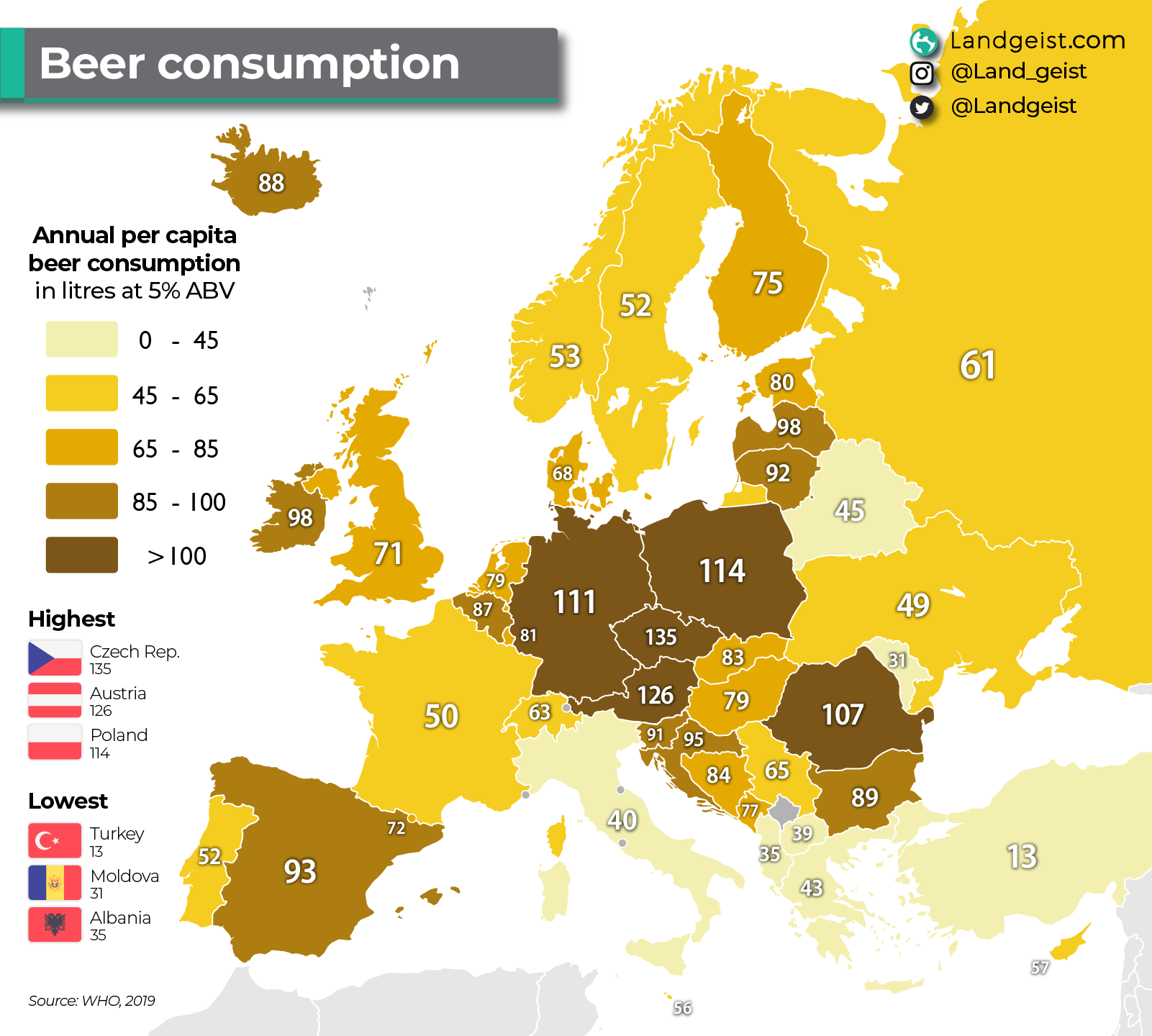Beer Consumption in Europe Map


David Chen
Data Visualization Specialist
David Chen is an expert in transforming complex geographic datasets into compelling visual narratives. He combines his background in computer science ...
Geographic Analysis
What This Map Shows
The "Beer Consumption in Europe Map" visually represents the average beer consumption per capita in various European countries. This map highlights the cultural significance of beer in different regions, shedding light on drinking habits and preferences across the continent. With its vibrant colors and clear distinctions, it paints a comprehensive picture of how beer is woven into the social fabric of European societies.
Deep Dive into Beer Consumption in Europe
Beer is more than just a beverage in Europe; it’s a cultural phenomenon that varies greatly from one nation to another. Interestingly, the tradition of brewing beer dates back thousands of years, with each country boasting its own unique styles and brewing techniques. As of the most recent data, the Czech Republic stands out as the global leader in beer consumption, with an impressive average of around 140 liters per person per year.
This fervent love for beer can be attributed to several factors, including historical brewing practices, social customs, and economic conditions. The Czech Republic's vibrant pub culture and the historical significance of pilsner-style lagers have played a pivotal role in shaping its beer consumption habits.
In contrast, Germany is another heavyweight in the beer consumption arena, famous for its beer purity law (Reinheitsgebot) and renowned festivals like Oktoberfest. The average German consumes about 100 liters of beer annually, showcasing a strong national identity tied to diverse beer styles such as wheat beers and rich bocks.
Interestingly, countries like Belgium, known for their high-quality, artisanal beers, have a lower per capita consumption, averaging around 70 liters annually. This reflects a culture that values quality over quantity, with a focus on savoring complex flavors rather than just hydration. Belgium’s unique brewing traditions, including Trappist beers and lambics, further enhance its reputation in the global beer community.
On the other end of the spectrum, countries such as the United Kingdom and Ireland, while historically significant in beer culture, have seen fluctuating consumption rates. The UK averages around 75 liters, while Ireland, with its famous stouts, stands at approximately 90 liters. The changes in consumption patterns in these regions can be linked to increasing health consciousness and evolving social norms.
Interestingly, the Nordic countries, often perceived as low beer consumption areas, have seen a rise in craft brewing, leading to new trends in beer appreciation. For instance, Sweden and Denmark, while having lower overall consumption, are experiencing a craft beer renaissance, attracting younger drinkers eager to explore innovative flavors.
Regional Analysis
When we break down the map by region, it becomes clear that Southern and Eastern Europe exhibit distinct beer consumption patterns compared to their Northern and Western counterparts. For instance, countries like Austria and Hungary showcase high consumption levels, largely due to their rich brewing traditions and social gatherings centered around beer. In these regions, beer is often consumed during communal meals, celebrations, and festivals, reinforcing its role as a social lubricant.
Conversely, Scandinavian countries display a different trend influenced by strict alcohol regulations and a cultural emphasis on moderation. While Denmark leads the Nordic countries with an average of around 90 liters, Norway and Finland lag behind, reflecting their unique approaches to alcohol consumption.
Southern Europe, particularly Spain and Italy, shows lower beer consumption figures, averaging around 40-50 liters per person. Here, wine often takes precedence due to historical and agricultural factors. However, craft beer movements in cities like Barcelona and Rome are gradually changing perceptions about beer, leading to increased interest among the younger populace.
Significance and Impact
The significance of beer consumption trends in Europe extends beyond mere statistics; they reflect deeper societal norms and economic conditions. As beer continues to be a staple in many cultures, understanding these patterns aids in recognizing shifts in public health, tourism, and even local economies. For instance, the rise of craft breweries has not only transformed consumption habits but has also created job opportunities and revitalized local economies.
Moreover, the current trends in beer consumption also illustrate how globalization is influencing local traditions. Many European countries are increasingly adopting craft beer styles from other regions, resulting in a dynamic fusion of tastes that enrich the continent's brewing landscape.
Looking to the future, it’s intriguing to consider how changing attitudes toward health and sustainability will shape beer consumption in Europe. The growing popularity of low-alcohol and alcohol-free beers indicates a shift toward more mindful drinking, which could redefine the way beer is integrated into social settings. Overall, the "Beer Consumption in Europe Map" not only highlights current consumption trends but also serves as a lens through which we can observe evolving cultural dynamics across the continent.
Visualization Details
- Published
- October 13, 2025
- Views
- 32
Comments
Loading comments...